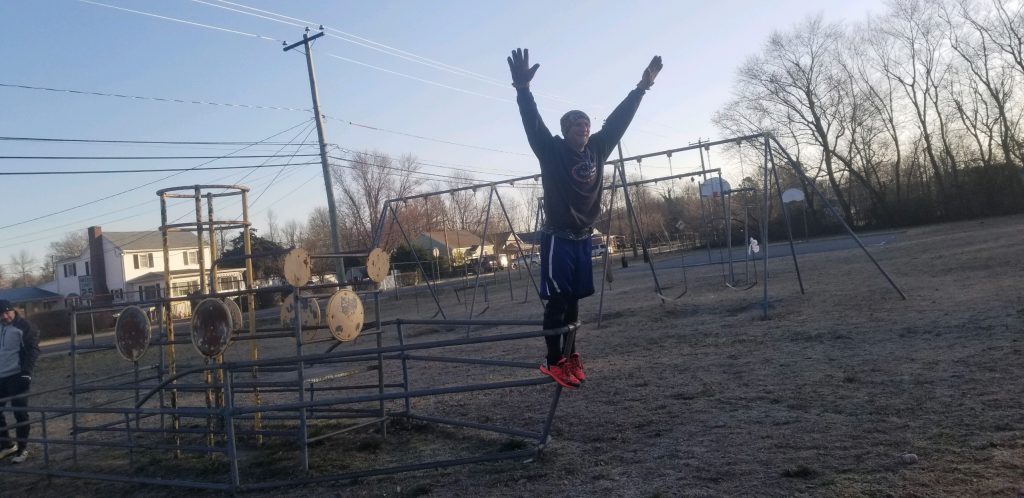- Pax: Chappie, Doubtfire, Fireplex, Poppa Bear, quattro, Ruxpin
- Posted In: Aegis, Georgetown
Aegis February 22, 2020
QIC: quattro
Warm-o-Rama
- 20 SSH IC
- 20 Cherry Pickers IC
- 20 Windmill IC
- Annie 10-counts IC
- Steve Earl 4-count IC
- 15 count playboys each side
- 7 Pretzel Merkins each side IC
THANG
- Mosey to Richard Allen School (where Q attended Kindergarten in 1985 [only one year mind you!]) parking lot, taking a quick pit stop for a set of fence hurdles at the Grace UMC park
- Circle up for Global Warming (10 burpees, 20 bobby hurleys, 50 lbc, 25 WWI situps)
- Time for recess!… Wosey to playground
- Split in 2 groups: 25 x 2 each swerkins, extra PAX do E2k until swings open up
- To the monkey bars: Merkins, while 1 PAX crosses monkey bars performing a newley-named workout “monkey junkers” 3x alternating regular, wide-arm, and diamond merkins
Break for 3rd F
Proverbs 22:28 "Do not move an ancient landmark which your fathers have set"
from Biography.com:
Born into slavery in 1760, Richard Allen later bought his freedom and went on to found the first national black church in the United States, the African Methodist Episcopal Church, in 1816.
Synopsis
Minister, educator and writer Richard Allen was born into slavery on February 14, 1760. He later converted to Methodism and bought his freedom. Fed up with the treatment of African-American parishioners at the St. George Episcopal congregation, he eventually founded the first national black church in the United States, the African Methodist Episcopal Church. He was also an activist and abolitionist whose ardent writings would inspire future visionaries. Allen died in 1831 in Philadelphia.
Background and Younger Years
Minister, educator and writer Richard Allen was born into slavery presumably in Philadelphia, Pennsylvania, on February 14, 1760. (As with other details surrounding Allen’s life, there have been some questions as to the place of his birth, with certain sources asserting that he was born in Delaware.) Known as “Negro Richard,” he and his family were sold by Benjamin Chew to a Delaware farmer, Stokeley Sturgis, sometime around 1768.
Allen converted to Methodism at the age of 17, after hearing a white itinerant Methodist preacher rail against slavery. His owner, who had already sold Richard’s mother and three of his siblings, also converted and eventually allowed Richard to purchase his freedom for $2,000, which he was able to do by 1783. The paper detailing Richard’s freedom would in fact become the first manumission document to be held as a public file, having been donated to the Pennsylvania Abolition Society.
After attaining his freedom, Richard took the last name “Allen” and returned to Philadelphia.
Early Religious and Social Work
Allen soon joined St. George’s Methodist Episcopal Church, where blacks and whites worshiped together. There, he became an assistant minister and conducted prayer meetings for African Americans. Frustrated with the limitations the church placed on him and black parishioners, which included segregating pews, Allen left the church as part of a mass walkout with the intention of creating an independent Methodist church. (While Allen gave the year of the walkout as 1787 in his own accounts, some scholars have asserted that the departure happened in 1792-93.)
Along with the Reverend Absalom Jones, who had also left St. George, Allen helped found the Free African Society, a non-denominational religious mutual-aid society dedicated to helping the black community. A century later, scholar and NAACP founder W.E.B. Du Bois called the FAS “the first wavering step of a people toward organized social life.” In 1794, Allen and several other black Methodists founded the Bethel Church, a black Episcopal meeting, in an old blacksmith’s shop. Bethel Church became known as “Mother Bethel” because it eventually birthed the African Methodist Episcopal Church. Helped by his second wife, Sarah, Allen also helped to hide escaped slaves, as the basement of the Bethel Church was a stop on the Underground Railroad.
Founding the African Methodist Episcopal Church
In 1799, Allen became the first African American to be ordained in the ministry of the Methodist Episcopal Church. Then, in 1816, with support from representatives from other black Methodist churches, Allen founded the first national black church in the United States, the African Methodist Episcopal Church, and became its first bishop. Today, the AME Church boasts more than 2.5 million members.
Understanding the power of an economic boycott, Allen went on to form the Free Produce Society, where members would only purchase products from non-slave labor, in 1830. With a vision of equal treatment for all, he railed against slavery, influencing later civil rights leaders such as Frederick Douglass and Martin Luther King Jr.
Death and Legacy
Allen died at his home on Spruce Street in Philadelphia, Pennsylvania, on March 26, 1831. He was laid to rest under Bethel Church.
In 2008, Richard Newman and NYU Press published an acclaimed biography of Allen—Freedom’s Prophet: Bishop Richard Allen, the AME Church and the Black Founding Fathers.
Richard Allen Coalition Inc in Georgetown opened its doors in the 1920s as one of the 80 schools built by Philanthropist Pierre S. DuPont for African-American children in Delaware. This is one of the “DuPont Colored Schools” that continued to serve as the heart of the African-American community for more than half a century.
Beginning in 1829 when public schools were established in Delaware, both white and black Delawareans paid schools taxes. However, the taxes supported schools for white students only. The few schools for African-Americans that existed relied on contributions from local churches for land and materials. The modest wooden buildings were built with community-based labor.
When desegregation was implemented, it became part of the Indian River School District. Five years ago, the school district decided to close the school and has been vacant since then.In 2010, a small group came together to form the Richard Allen Coalition Inc. We are a diverse group with a common goal: to restore the school so it can once again be a cultural, civic, and educational center. We found so much history in this school which has never been recorded, including baseball games held on the field behind the school and baseball teams formed by Luther Tingle.On August 12, 2015, Phase I of our journey was completed when Governor Jack Markell signed the bill sponsored by Senator Brian Pettyjohn and Representative Ruth Briggs King which deeded the building to the Richard Allen Coalition. Phase II was a kick off with a gala at the Georgetown Cheer Center on February 6, 2016, which was a success.
Today, we are hosting programs on the grounds for the community. There has been considerable work within the building. With the community help, we have painted, sanded and worked to bring portions of the building into a useable facility. We are continuing to raise the funding needed to begin the renovation and restoration project of the Richard Allen Coalition School. It is an ambitious goal, but with the help of the grants, civic and business leaders of Sussex County, we can do it efficiently.
When Richard Allen School opened its door, it was a beacon of hope for African-Americans living in Jim Crow Delaware. When it opened, it welcomed all of us who wanted to learn about the past while helping our youth explore their talents and prepare for a wonderful future.
The state of Delaware mandated racially segregated schools until 1967. The Act of Free Schools of 1829 provided public education in Delaware, but taxes levied on both white and black citizens supported schools for white students only.
A few schools for blacks existed in the early 20th century but all land and material were acquired with contributions from local churches, and the modest wooden buildings were built with community-based labor.Pierre S. DuPont, appalled by the unfair tax system and the lack of educational opportunities for Delaware’s’ black students, donated the funds to build more than 80 schools for black students throughout the state in the 1920s.
- Be the man in the boat: Abyss big boys while legs are hooked into side of playground boat -25 IC amid plenty of mumble chatter

- Mosey back to the Circle
Count-o-Rama
Name-o-Rama
COT
Respectfully submitted, quattro

